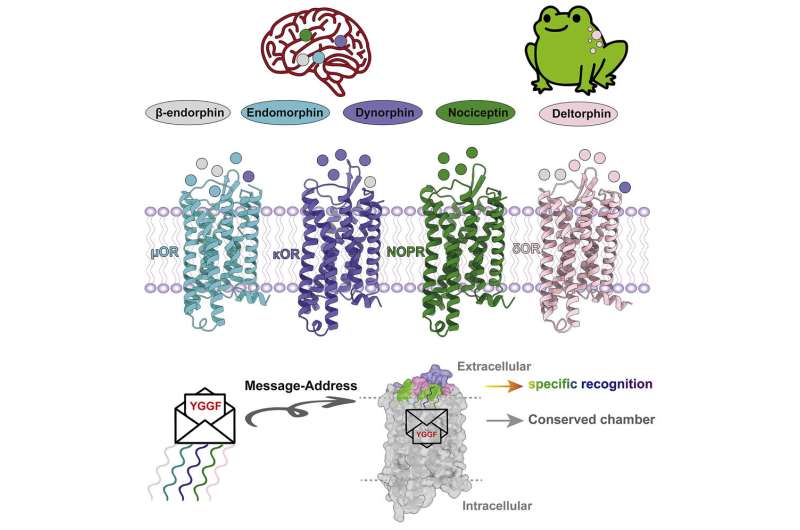This article has been reviewed according to Science X's editorial process and policies. Editors have highlighted the following attributes while ensuring the content's credibility:
fact-checked
peer-reviewed publication
trusted source
proofread
Scientists take another step toward creating better pain medications

In the continuing effort to improve upon opioid pain relievers, American and Chinese scientists used cryoEM technology to solve the detailed structures of the entire family of opioid receptors bound to their naturally occurring peptides. Subsequent structure-guided biochemical studies were then performed to better understand the mechanisms of peptide-receptor selectivity and signaling drugs.
This work, published in Cell, provides a comprehensive structural framework that should help drug developers rationally design safer drugs to relieve severe pain.
This work was spearheaded by the lab of Eric Xu, Ph.D., at the CAS Key Lab of Receptor Research in China, in collaboration with the lab of Bryan L. Roth, MD, Ph.D., at the UNC School of Medicine, where graduate student Jeff DiBerto led the pharmacological experiments to understand the receptors' signaling mechanisms.
Opioid drugs relieve pain by mimicking a naturally occurring pain-relief function within our nervous symptoms. They are the best, strongest pain relievers we have. Unfortunately, they come with side effects, some severe such as numbness, addiction, and respiratory depression, leading to overdose deaths.
Scientists have been trying for many years to overcome the side-effect problem in various ways, all involving one or more of four opioid receptors to no avail. One way scientists continue to explore is the creation of peptide or peptide-inspired small molecule drugs.
Peptides are short chains of amino acids; think of them as short proteins. Certain naturally occurring, or endogenous, peptides bind to opioid receptors on the surface of cells to create an analgesic effect, also known as pain relief. Think of an analgesic like an anesthetic, except that analgesics do not "turn off" the nerves to numb the body or alter consciousness. So, the idea is to create a peptide drug that has a strong analgesic effect, without numbing nerves or altering consciousness or causing digestive, respiratory, or addiction issues.
"The problem in the field is we've lacked the molecular understanding of the interplay between opioid peptides and their receptors," said Roth, co-senior author and the Michael Hooker Distinguished Professor of Pharmacology. "We've needed this understanding in order to try to rationally design potent and safe peptide or peptide-inspired drugs."
Using cryogenic electron microscopy, or cryoEM, and a battery of biomechanistic experiments in cells, the Xu and Roth labs systematically solved the detailed structures of endogenous peptides bound to all four opioid receptors. These structures revealed details and insights into how specific naturally occurring opioid peptides selectively recognize and activate opioid receptors. The researchers also used exogenous peptides, or drug-like compounds, in some of their experiments to learn how they activate the receptors.
The cryoEM structures of agonist-bound receptors in complex with their G protein effectors (called their "active state") represents what these receptors look like when they are signaling in cells, giving a detailed view of peptide-receptor interactions. The Roth lab used the structures solved by the Xu lab to guide the design of mutant receptors, and then tested these receptors in biochemical assays in cells to determine how they alter receptor signaling. Understanding these interactions can then be used to design drugs that are selective for opioid receptor subtypes, as well as to produce certain signaling outcomes that may be more beneficial than those of conventional opioids.
"This collaboration revealed conserved, or shared, mechanisms of activation and recognition of all four opioid receptors, as well as differences in peptide recognition that can be exploited for creating subtype-selective drugs," said DiBerto, first author and Ph.D. candidate in the Roth lab. "We provide more needed information to keep pushing the field forward, to answer basic science questions we hadn't been able to answer before now."
Previous research showed the structure of opioid receptors in their inactive or active-like states, with active state structures only existing for the mu-opioid receptor subtype, the primary target of drugs like fentanyl and morphine. In the Cell paper, the authors show agonist-bound receptors in in complex with their G protein effectors, made possible through cryoEM technology that did not exist when currently used medications were being developed.
Drugs such as oxycontin, oxycodone, and morphine cause various effects inside cells and throughout the nervous symptom, including pain relief. But they have effects in the digestive and respiratory systems, too, and interact with cells to lead to addiction. Fentanyl, meanwhile, is another powerful pain reliever, but it binds to opioid receptors in such a way as to cause severe side effects, including the shutdown of the respiratory system.
The thrust behind such research led by Xu and Roth is to home in on the mechanistic reasons for pain relief potency without triggering the cellular mechanisms that lead to severe side effects and overdosing.
"We are attempting to build a better kind of opioid," Roth says, "We're never going to get there without these kind of basic molecular insights, wherein we can see why pain is relieved and why side effects occur."
More information: Yue Wang et al, Structures of the entire human opioid receptor family, Cell (2023). DOI: 10.1016/j.cell.2022.12.026
Journal information: Cell
Provided by University of North Carolina School of Medicine




















